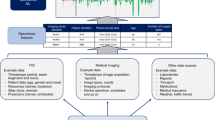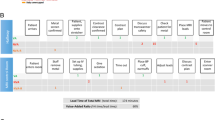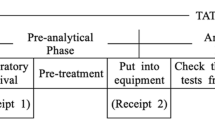Abstract
The principles of 'lean management' have permeated many sectors of today's business world, secondary to the success of the Toyota Production System. This management method enables workers to eliminate mistakes, reduce delays, lower costs, and improve the overall quality of the product or service they deliver. These lean management principles can be applied to health care. Their implementation within the ambulatory care setting is predicated on the continuous identification and elimination of waste within the process. The key concepts of flow time, inventory and throughput are utilized to improve the flow of patients through the clinic, and to identify points that slow this process—so-called bottlenecks. Nonessential activities are shifted away from bottlenecks (i.e. the physician), and extra work capacity is generated from existing resources, rather than being added. The additional work capacity facilitates a more efficient response to variability, which in turn results in cost savings, more time for the physician to interact with patients, and faster completion of patient visits. Finally, application of the lean management principle of 'just-in-time' management can eliminate excess clinic inventory, better synchronize office supply with patient demand, and reduce costs.
Key Points
-
'Lean management' principles, encapsulated by the Toyota Production System of automobile manufacture, can be employed in ambulatory health-care clinics to optimize patient throughput without compromising patient safety or satisfaction
-
The central tenet of lean management is continuous and systematic identification and elimination of waste by workers (as opposed to higher management)
-
Limiting variability and removing noncritical activities from the process 'bottleneck' (often the physician in an ambulatory clinic) are essential to successful implementation of lean management concepts
-
Strategic scheduling of patients with differing needs (i.e. new, return, procedure-related) can minimize variability
-
Work capacity can be increased by improving the efficiency of existing resources, rather than investing in additional resources
This is a preview of subscription content, access via your institution
Access options
Subscribe to this journal
Receive 12 print issues and online access
$209.00 per year
only $17.42 per issue
Buy this article
- Purchase on Springer Link
- Instant access to full article PDF
Prices may be subject to local taxes which are calculated during checkout

Similar content being viewed by others
References
McClellan MB (21 July 2005). Testimony of Mark B. McClellan, MD, PhD, Administrator, Before the House Ways and Means Subcommittee on Health on Value-Based Purchasing for Physicians Under Medicare. Washington, DC: Centers for Medicare & Medicaid Services
Kohn LT et al. (Eds; 2000) To Err is Human: Building a Safer Health System. Washington, DC: National Academy Press
Committee on Quality Health Care in America, Institute of Medicine (2001) Crossing the Quality Chasm: a New Health System for the 21st Century. Washington, DC: National Academy Press
Eitel DR et al. (2008) Improving service quality by understanding emergency department flow: a white paper and position statement prepared for the American Academy of Emergency Medicine. J Emerg Med [doi:10.1016/j.jemermed.2008.03.038]
Spear S and Bowen HK (1999) Decoding the DNA of the Toyota Production System. Harv Bus Rev 77: 96–106
Prentice JC and Pizer SD (2007) Delayed access to health care and mortality. Health Serv Res 42: 644–662
Green LV et al. (2007) Providing timely access to care: what is the right patient panel size? Jt Comm J Qual Patient Saf 33: 211–218
Murray M and Berwick DM (2003) Advanced access: reducing waiting and delays in primary care. JAMA 289: 1035–1040
Schall MW et al. (2004) Improving patient access to the Veterans Health Administration's primary care and specialty clinics. Jt Comm J Qual Saf 30: 415–423
Hankinson MT et al. (2006) Sustained improvement for specialty clinic access. Jt Comm J Qual Patient Saf 32: 142–151
Pomerantz A et al. (2008) Improving efficiency and access to mental health care: combining integrated care and advanced access. Gen Hosp Psychiatry 30: 546–551
Murray M et al. (2003) Improving timely access to primary care: case studies of the advanced access model. JAMA 289: 1042–1046
Mehrotra AM et al. (2008) Implementing open-access scheduling of visits in primary care practices: a cautionary tale. Ann Intern Med 148: 915–922
Ben-Tovim DI et al. (2007) Lean thinking across a hospital: redesigning care at the Flinders Medical Centre. Aust Health Rev 31: 10–15
Dickson EW et al. (2008) Application of lean manufacturing techniques in the emergency department. J Emerg Med [doi:10.1016/j.jemermed.2007.11.108]
Serrano L and Slunecka FW (2006) Lean processes improve patient care. Observing processes through patients' eyes can lead to improvements. Healthc Exec 21: 36–38
Spear SJ (2005) Fixing health care from the inside, today. Harv Bus Rev 83: 78–91
Thompson DN et al. (2003) Driving improvement in patient care: lessons from Toyota. J Nurs Adm 33: 585–595
Nelson-Peterson DL and Leppa CJ (2007) Creating an environment for caring using lean principles of the Virginia Mason Production System. Jt Comm J Qual Patient Saf 37: 287–294
Jimmerson C et al. (2005) Reducing waste and errors: piloting lean principles at Intermountain Healthcare. Jt Comm J Qual Patient Saf 31: 249–257
Sunyog M (2004) Lean management and six-sigma yield big gains in hospital's immediate response laboratory. Clin Leadersh Manag Rev 18: 255–258
Furman C and Caplan R (2007) Applying the Toyota Production System: using a patient safety alert system to reduce error. Jt Comm J Qual Patient Saf 33: 376–386
Page L (2005) Getting the skinny on lean management. Mater Manag Health Care 14: 26–29
Kim CS et al. (2009) Lean health care: what can hospitals learn from a world-class automaker? J Hosp Med 1: 191–199
Endsley S et al. (2006) Creating a lean practice. Fam Pract Manag 13: 34–38
Schultz K et al. (2007) Care transitions in the outpatient surgery preoperative process: facilitators and obstacles to information flow and their consequences. Cogn Technol Work 9: 219–231
Anupindi R et al. (2006) Managing Business Process Flows: Principles of Operations Management. Upper Saddle River: Pearson Prentice Hall
Mulvehill MJ III (2001) Operations management: a tool to increase profitability. J Calif Dent Assoc 29: 227–230
Stewart M (1993) Pick and pack: a just-in-time forms order and delivery system. J Healthc Mater Manag 11: 36–41
Gonzalez CM et al. (2006) Significant clinical practice cost savings through downsizing office supply inventory and just in time ordering. J Urol 176: 267–269
Friedman BB (1994) Controlling inventory in a small specialty hospital. HospMater Manag Q 15: 8–13
Scanlin T (1997) A case for “just in time:” could it be right for your hospital, too? J Healthc Resour Manag 15: 10–14
Liker JK (Ed.; 1998) Becoming Lean: Inside Stories of US Manufacturers. Portland: Productivity Press
Ruffa SA (2008) Going Lean: How the Best Companies Apply Lean Manufacturing Principles to Shatter Uncertainty, Drive Innovation, and Maximize Profits. New York: AMACOM
Spear SJ (2006) Fixing healthcare from the inside: teaching residents to heal broken delivery processes as they heal sick patients. Acad Med 81: S144–S149
Acknowledgements
Professor S Chopra was an outstanding teacher of lean management principles in the Kellogg School of Management. Professor M Lariviere also taught many of these concepts at the Kellogg School of Management.
Author information
Authors and Affiliations
Corresponding author
Ethics declarations
Competing interests
The authors declare no competing financial interests.
Rights and permissions
About this article
Cite this article
Casey, J., Brinton, T. & Gonzalez, C. Utilization of lean management principles in the ambulatory clinic setting. Nat Rev Urol 6, 146–153 (2009). https://doi.org/10.1038/ncpuro1320
Received:
Accepted:
Issue Date:
DOI: https://doi.org/10.1038/ncpuro1320
This article is cited by
-
Accuracy of Patient’s Turnover Time Prediction Using RFID Technology in an Academic Ambulatory Surgery Center
Journal of Medical Systems (2015)
-
Lean management in health care: definition, concepts, methodology and effects reported (systematic review protocol)
Systematic Reviews (2014)
-
Interactions between lean management and the psychosocial work environment in a hospital setting – a multi-method study
BMC Health Services Research (2014)
-
Lean manufacturing and Toyota Production System terminology applied to the procurement of vascular stents in interventional radiology
Insights into Imaging (2011)



